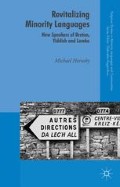Abstract
The European Parliament’s Intergroup for Traditional Minorities, National Communities and Languages, inaugurated in early 2015, is a sign of the increasing interest in minority language matters at the transnational level of government in the EU. Most EU member states (and indeed some non-EU states as well) have signed the European Charter for Regional or Minority Languages and twenty-five of them have ratified it. On one level this is not surprising, since national minorities make up eight per cent of the European Union’s population while regional or minority languages are spoken by nearly fifty million people, ten per cent of the EU population. On the other hand, initiatives such as these may be viewed as merely catching up with reality, especially at grassroots levels. Particularly within the field of education, measures to sustain or increase the number of speakers of minority languages have been around for some time now in places such as Scotland, Wales, Ireland, the Basque Country and Brittany, among many others. If the aim was originally, as in the case of Wales, to provide schooling in the local indigenous minority language for L1 speakers, then this scenario has drastically changed over the course of the twentieth and twenty-first centuries, to the point where many minority language schools in various parts of Europe are providing minority language education for L2 speakers. These initiatives are accompanied by a growing number of adult learners/users of minority languages who have taken up the challenge of adopting what were once perceived to be low-status languages. These ‘new’ speakers thus emerge as a result of language policies aimed at revitalizing minoritized languages, and which further aim to ameliorate the social position of minoritized languages and their speakers, and facilitate their incorporation into a greater range of social and linguistic domains. With a perceived increase in the economic value of these languages, languages such as Gaelic, Welsh, Irish and Basque can become more integral to labour markets in education, the media or public administration.
Access this chapter
Tax calculation will be finalised at checkout
Purchases are for personal use only
Preview
Unable to display preview. Download preview PDF.
Author information
Authors and Affiliations
Copyright information
© 2015 Michael Hornsby
About this chapter
Cite this chapter
Hornsby, M. (2015). Introduction. In: Revitalizing Minority Languages. Palgrave Studies in Minority Languages and Communities. Palgrave Macmillan, London. https://doi.org/10.1057/9781137498809_1
Download citation
DOI: https://doi.org/10.1057/9781137498809_1
Publisher Name: Palgrave Macmillan, London
Print ISBN: 978-1-349-57148-2
Online ISBN: 978-1-137-49880-9
eBook Packages: Palgrave Social Sciences CollectionSocial Sciences (R0)

